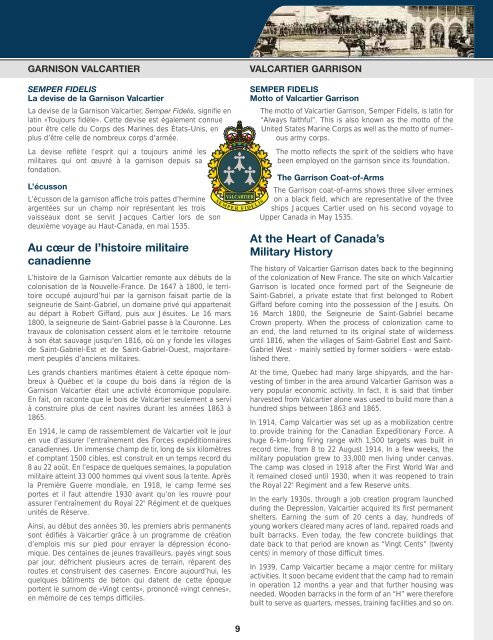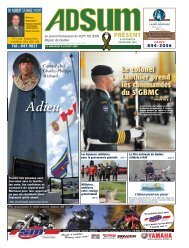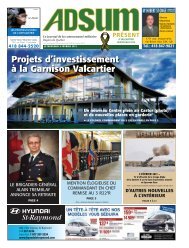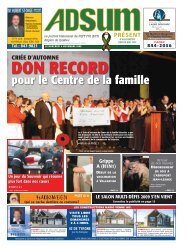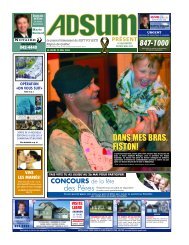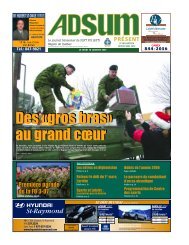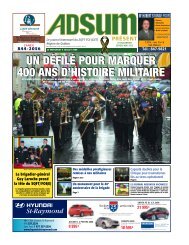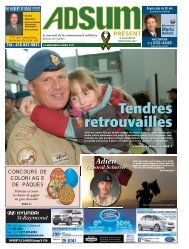MILITAIRE MILITARY - Journal Adsum
MILITAIRE MILITARY - Journal Adsum
MILITAIRE MILITARY - Journal Adsum
Create successful ePaper yourself
Turn your PDF publications into a flip-book with our unique Google optimized e-Paper software.
GARNISON VALCARTIER VALCARTIER GARRISON<br />
SEMPER FIDELIS<br />
La devise de la Garnison Valcartier<br />
La devise de la Garnison Valcartier, Semper Fidelis, signifie en<br />
latin «Toujours fidèle». Cette devise est également connue<br />
pour être celle du Corps des Marines des États-Unis, en<br />
plus d’être celle de nombreux corps d'armée.<br />
La devise reflète l’esprit qui a toujours animé les<br />
militaires qui ont œuvré à la garnison depuis sa<br />
fondation.<br />
L’écusson<br />
L’écusson de la garnison affiche trois pattes d’hermine<br />
argentées sur un champ noir représentant les trois<br />
vaisseaux dont se servit Jacques Cartier lors de son<br />
deuxième voyage au Haut-Canada, en mai 1535.<br />
Au cœur de l’histoire militaire<br />
canadienne<br />
L’histoire de la Garnison Valcartier remonte aux débuts de la<br />
colonisation de la Nouvelle-France. De 1647 à 1800, le territoire<br />
occupé aujourd’hui par la garnison faisait partie de la<br />
seigneurie de Saint-Gabriel, un domaine privé qui appartenait<br />
au départ à Robert Giffard, puis aux Jésuites. Le 16 mars<br />
1800, la seigneurie de Saint-Gabriel passe à la Couronne. Les<br />
travaux de colonisation cessent alors et le territoire retourne<br />
à son état sauvage jusqu’en 1816, où on y fonde les villages<br />
de Saint-Gabriel-Est et de Saint-Gabriel-Ouest, majoritairement<br />
peuplés d’anciens militaires.<br />
Les grands chantiers maritimes étaient à cette époque nombreux<br />
à Québec et la coupe du bois dans la région de la<br />
Garnison Valcartier était une activité économique populaire.<br />
En fait, on raconte que le bois de Valcartier seulement a servi<br />
à construire plus de cent navires durant les années 1863 à<br />
1865.<br />
En 1914, le camp de rassemblement de Valcartier voit le jour<br />
en vue d’assurer l’entraînement des Forces expéditionnaires<br />
canadiennes. Un immense champ de tir, long de six kilomètres<br />
et comptant 1500 cibles, est construit en un temps record du<br />
8 au 22 août. En l’espace de quelques semaines, la population<br />
militaire atteint 33 000 hommes qui vivent sous la tente. Après<br />
la Première Guerre mondiale, en 1918, le camp ferme ses<br />
portes et il faut attendre 1930 avant qu’on les rouvre pour<br />
assurer l’entraînement du Royal 22 e Régiment et de quelques<br />
unités de Réserve.<br />
Ainsi, au début des années 30, les premiers abris permanents<br />
sont édifiés à Valcartier grâce à un programme de création<br />
d’emplois mis sur pied pour enrayer la dépression éco no -<br />
mique. Des centaines de jeunes travailleurs, payés vingt sous<br />
par jour, défrichent plusieurs acres de terrain, réparent des<br />
routes et construisent des casernes. Encore aujourd’hui, les<br />
quelques bâtiments de béton qui datent de cette époque<br />
portent le surnom de «Vingt cents», prononcé «vingt cennes»,<br />
en mémoire de ces temps difficiles.<br />
VALCARTIER<br />
S E M P E R F I D E L I S<br />
9<br />
SEMPER FIDELIS<br />
Motto of Valcartier Garrison<br />
The motto of Valcartier Garrison, Semper Fidelis, is latin for<br />
“Always faithful”. This is also known as the motto of the<br />
United States Marine Corps as well as the motto of numerous<br />
army corps.<br />
The motto reflects the spirit of the soldiers who have<br />
been employed on the garrison since its foundation.<br />
The Garrison Coat-of-Arms<br />
The Garrison coat-of-arms shows three silver ermines<br />
on a black field, which are representative of the three<br />
ships Jacques Cartier used on his second voyage to<br />
Upper Canada in May 1535.<br />
At the Heart of Canada’s<br />
Military History<br />
The history of Valcartier Garrison dates back to the beginning<br />
of the colonization of New France. The site on which Valcartier<br />
Garrison is located once formed part of the Seigneurie de<br />
Saint-Gabriel, a private estate that first belonged to Robert<br />
Giffard before coming into the possession of the Jesuits. On<br />
16 March 1800, the Seigneurie de Saint-Gabriel became<br />
Crown property. When the process of colonization came to<br />
an end, the land returned to its original state of wilderness<br />
until 1816, when the villages of Saint-Gabriel East and Saint-<br />
Gabriel West - mainly settled by former soldiers - were established<br />
there.<br />
At the time, Quebec had many large shipyards, and the harvesting<br />
of timber in the area around Valcartier Garrison was a<br />
very popular economic activity. In fact, it is said that timber<br />
harvested from Valcartier alone was used to build more than a<br />
hundred ships between 1863 and 1865.<br />
In 1914, Camp Valcartier was set up as a mobilization centre<br />
to provide training for the Canadian Expeditionary Force. A<br />
huge 6-km-long firing range with 1,500 targets was built in<br />
record time, from 8 to 22 August 1914. In a few weeks, the<br />
military population grew to 33,000 men living under canvas.<br />
The camp was closed in 1918 after the First World War and<br />
it remained closed until 1930, when it was reopened to train<br />
the Royal 22 e Regiment and a few Reserve units.<br />
In the early 1930s, through a job creation program launched<br />
during the Depression, Valcartier acquired its first permanent<br />
shelters. Earning the sum of 20 cents a day, hundreds of<br />
young workers cleared many acres of land, repaired roads and<br />
built barracks. Even today, the few concrete buildings that<br />
date back to that period are known as “Vingt Cents’’ (twenty<br />
cents) in memory of those difficult times.<br />
In 1939, Camp Valcartier became a major centre for military<br />
activities. It soon became evident that the camp had to remain<br />
in operation 12 months a year and that further housing was<br />
needed. Wooden barracks in the form of an “H’’ were therefore<br />
built to serve as quarters, messes, training facilities and so on.


